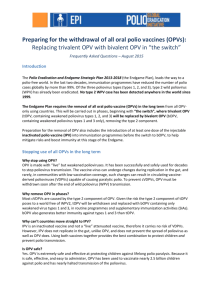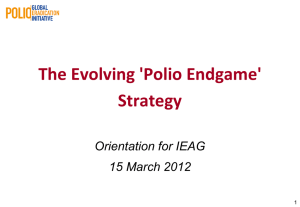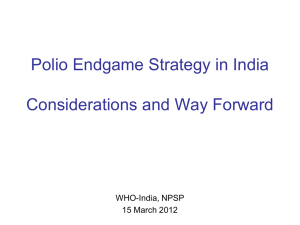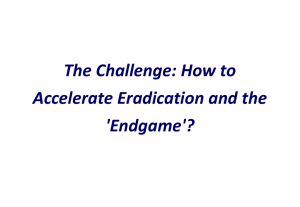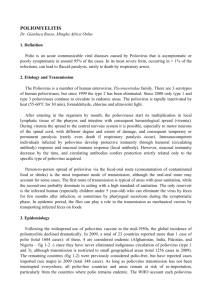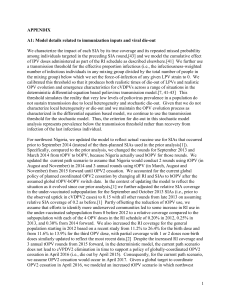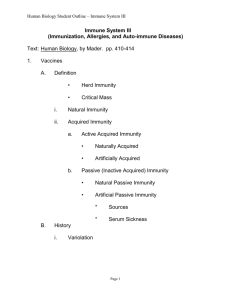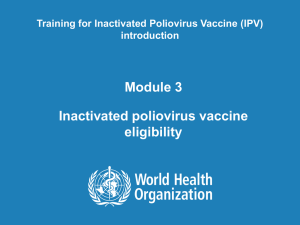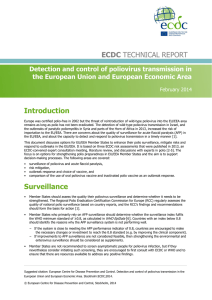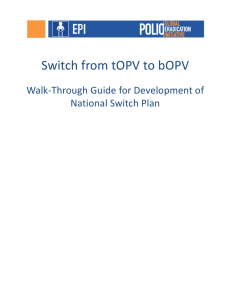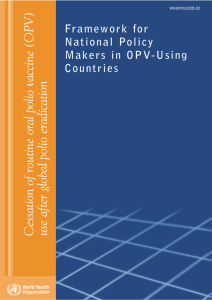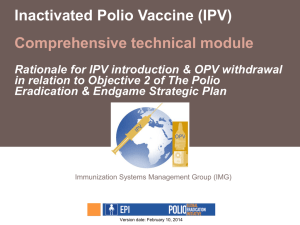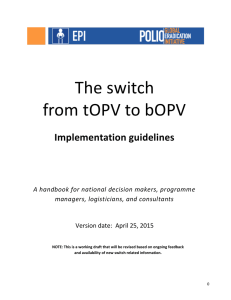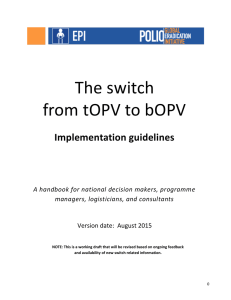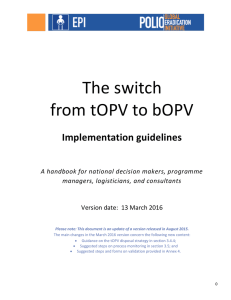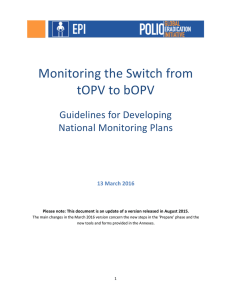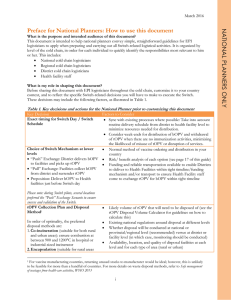Type 2 OPV withdrawal: update on readiness and preparations for... Background
advertisement
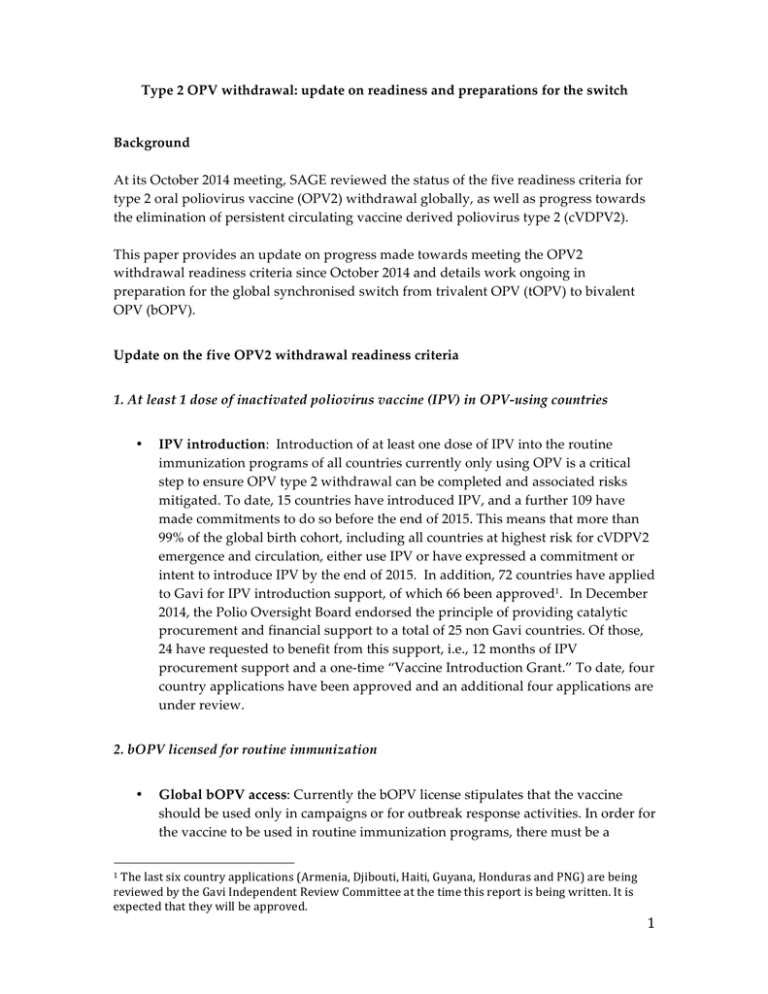
Type 2 OPV withdrawal: update on readiness and preparations for the switch Background At its October 2014 meeting, SAGE reviewed the status of the five readiness criteria for type 2 oral poliovirus vaccine (OPV2) withdrawal globally, as well as progress towards the elimination of persistent circulating vaccine derived poliovirus type 2 (cVDPV2). This paper provides an update on progress made towards meeting the OPV2 withdrawal readiness criteria since October 2014 and details work ongoing in preparation for the global synchronised switch from trivalent OPV (tOPV) to bivalent OPV (bOPV). Update on the five OPV2 withdrawal readiness criteria 1. At least 1 dose of inactivated poliovirus vaccine (IPV) in OPV-­‐‑using countries • IPV introduction: Introduction of at least one dose of IPV into the routine immunization programs of all countries currently only using OPV is a critical step to ensure OPV type 2 withdrawal can be completed and associated risks mitigated. To date, 15 countries have introduced IPV, and a further 109 have made commitments to do so before the end of 2015. This means that more than 99% of the global birth cohort, including all countries at highest risk for cVDPV2 emergence and circulation, either use IPV or have expressed a commitment or intent to introduce IPV by the end of 2015. In addition, 72 countries have applied to Gavi for IPV introduction support, of which 66 been approved1. In December 2014, the Polio Oversight Board endorsed the principle of providing catalytic procurement and financial support to a total of 25 non Gavi countries. Of those, 24 have requested to benefit from this support, i.e., 12 months of IPV procurement support and a one-­‐‑time “Vaccine Introduction Grant.” To date, four country applications have been approved and an additional four applications are under review. 2. bOPV licensed for routine immunization • Global bOPV access: Currently the bOPV license stipulates that the vaccine should be used only in campaigns or for outbreak response activities. In order for the vaccine to be used in routine immunization programs, there must be a 1 The last six country applications (Armenia, Djibouti, Haiti, Guyana, Honduras and PNG) are being reviewed by the Gavi Independent Review Committee at the time this report is being written. It is expected that they will be approved. 1 variation of the vaccine label. To date, three manufacturers/fillers have applied to their national regulators for such a label change. Approval is expected by end of Q2/2015. In addition, in order to facilitate rapid access to bOPV, a World Health Assembly resolution will be put forward in May 2015 that will urge member states to grant an exceptional authorization for the use of bOPV in routine programmes based on WHO Pre-­‐‑Qualification while national licensing procedures are on-­‐‑going. 3. Type 2 poliovirus surveillance and response protocols and monovalent OPV (mOPV) stockpile • Type 2 surveillance: In October, SAGE endorsed the plans for the expansion of environmental surveillance according to the following criteria: o Sustain in endemic areas and expand to capture “silent” areas within endemic countries o Establish in priority countries along overland exportation routes o Establish in priority areas for cVDPV emergence (ie the Tier 1 countries), Since the last meeting, new sites have been established in Nigeria, Pakistan and Afghanistan, and site assessments and laboratory capacity building has taken place in a number of countries in Central and West Africa. Further expansion is planned in the Middle East and Horn of Africa. • Constitution of a mOPV2 stockpile: A global mOPV2 stockpile is being established to deal with any OPV type 2 outbreaks that may occur after the withdrawal of type 2 OPV. The protocol for the management and operationalization of the stockpile was endorsed by SAGE in October 2014 which will ensure the rapid detection and confirmation of outbreaks, and deployment of vaccines after authorization by the Director General of WHO. A total of 500 million doses of mOPV2 in bulk have already been secured from two manufacturers. A tender has been issued for filling 100 million of these doses in vials. 4. Appropriate containment and handling of residual type 2 materials • Containment: In October, the strategic approach and plan for fully aligning the containment of polioviruses with the major milestones and timelines of the Polio Eradication and Endgame Strategic Plan 2013‒2018 was finalized and endorsed by SAGE. The WHO global action plan to minimize poliovirus facility-­‐‑associated risk after type-­‐‑specific eradication of wild polioviruses and sequential cessation of OPV use (called GAPIII) establishes specific measures for the poliovirus type 2 containment phase of the polio endgame; differentiates the requirements for facilities holding wild versus Sabin-­‐‑strain polioviruses; and sets parameters for 2 the long-­‐‑term containment of polioviruses following the eventual cessation of vaccination with all oral poliovirus vaccines after 2019. All Members States are now being approached to update and finalize their inventories of facilities holding wild and Sabin polioviruses which need to be informed of the impending requirements to contain all type 2 polioviruses, including preparations for destruction or containment of all type 2 wild poliovirus (WPV) including vaccine-­‐‑derived strains by the end of 2015, and type 2 OPV/Sabin within three months of OPV2 withdrawal. 5. Verification of global eradication of wild poliovirus type 2 • Verification of WPV2 eradication: Following the WHO Executive Board (February 2015), Regional Directors agreed to write to all member states and invite them to provide a formal statement to the Regional Certification Commissions and to WHO to confirm when WPV2 was last detected in their country . On the basis of the evidence received from regional certification commissions, the Global Certification Commission will then be able to confirm the eradication of wild polio virus type 2. The next Global Certification Commission meeting is planned for the second half of 2015. Elimination of persistent cVDPV2: The elimination of persistent lineages of cVDPV2 is a pre-­‐‑requisite to the withdrawal of type 2 OPV. A separate document describes the epidemiological status and the on-­‐‑going and planned response to persistent cVDPV2. Update on the planning for the switch from tOPV to bOPV In addition to ensuring the readiness criteria are met, significant planning is required at all levels to ensure countries have the necessary information, guidance and support to implement OPV type 2 withdrawal and switch from tOPV to bOPV. Key areas of work ongoing are as follows: • • Technical Guidance and Standard Operating Procedures: The global switch from tOPV to bOPV is planned to take place during a two week window in April 2016. In order to ensure countries are prepared, detailed guidance notes and standard operating procedures have been developed and distributed. All countries are required to have developed a plan for the switch by the end of Q3/2015. Dry runs will be conducted in a few selected countries during Q2/2015 to simulate the switch itself and identify any unforeseen problems. Technical assistance to countries is available through WHO and UNICEF offices as well as via the STOP team members deployed by the two agencies. Supply: Managing tOPV and bOPV supplies to ensure there is enough of the right type of vaccine at the right time will be critical to successful implementation of the 3 • switch. Detailed supply planning, under the leadership of UNICEF supply division, is ongoing. Member States are advised and supported to precisely forecast the amount of tOPV they need to avoid over-­‐‑stocking; this is especially important for self-­‐‑procuring countries who run not just financial risks with over-­‐‑ordering of tOPV but the risk of not being able to get sufficient bOPV in time. Special attention is being paid to this area of work and personnel are being recruited to manage it. Communications: A package of information materials has been developed to provide more detailed information to countries and partners, and support advocacy efforts. These are available on the WHO website2 and are also being distributed at EPI manager meetings, where sessions on the switch are being conducted. In addition, a series of educational webinars will be held in March for global and regional level partners. At the end of March, a joint letter signed by the Director General of WHO and by the Executive Director of UNICEF will be sent to all 156 tOPV using countries and territories to emphasise the importance of the switch to bOPV as an integral part of the Polio Eradication and End Game Strategic plan. 2 http://www.who.int/immunization/diseases/poliomyelitis/endgame_objective2/en/ 4
